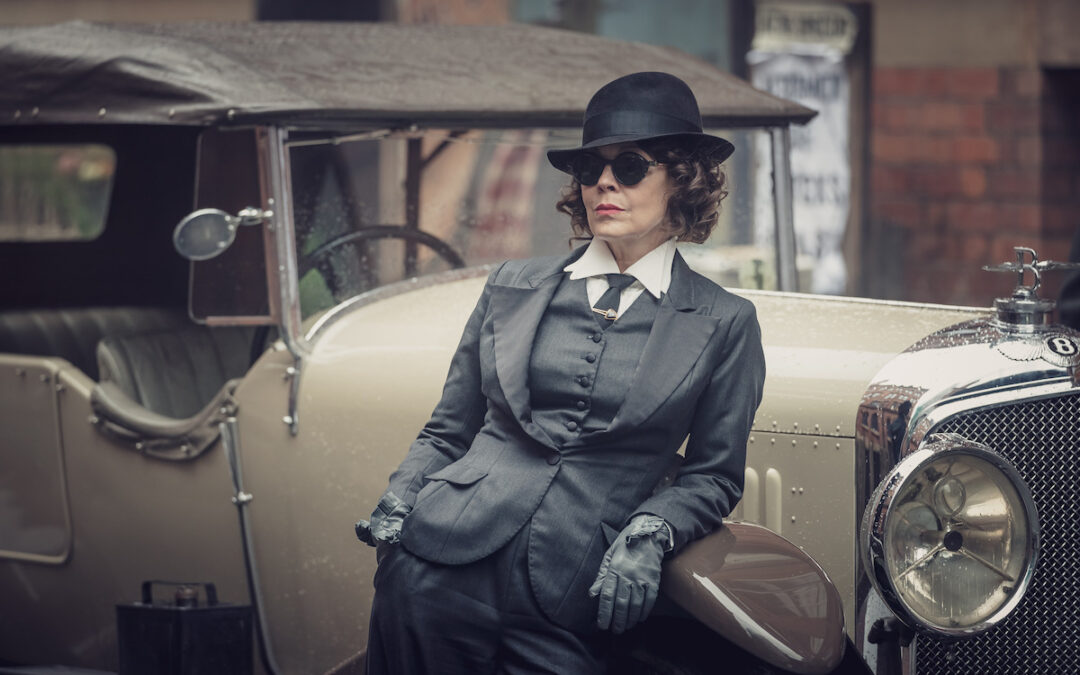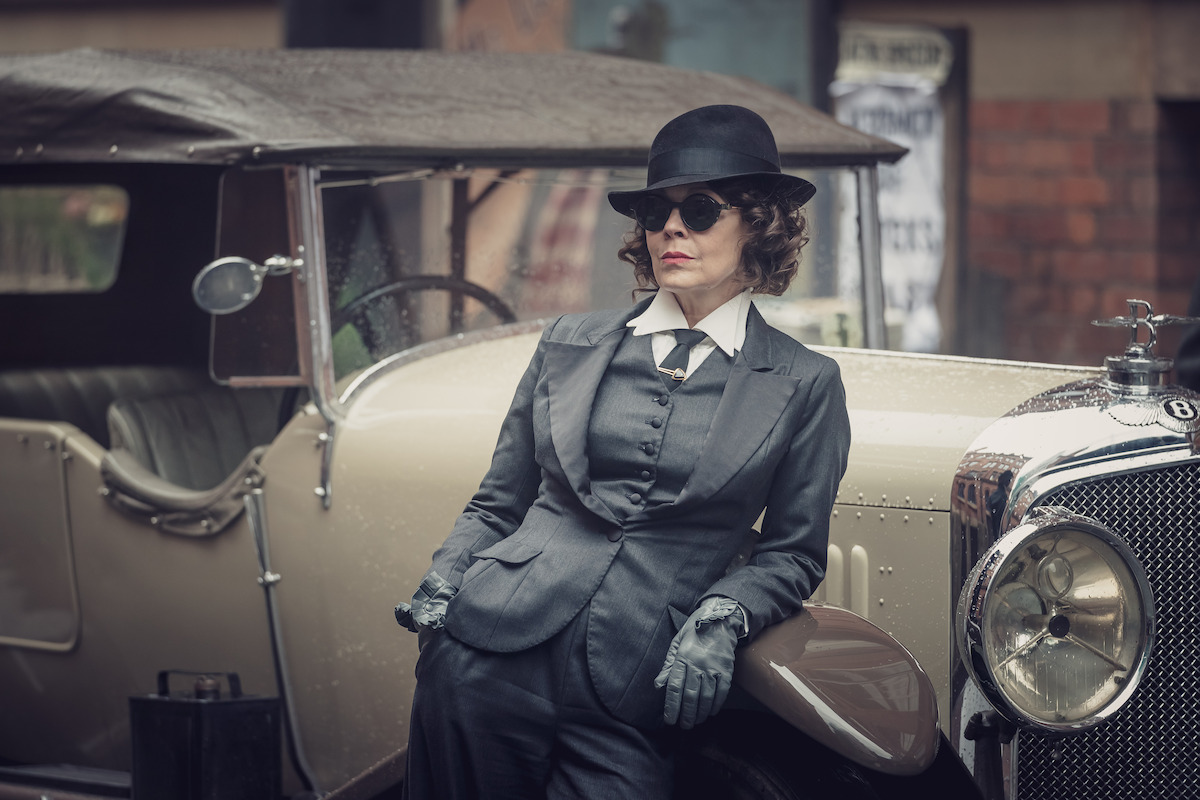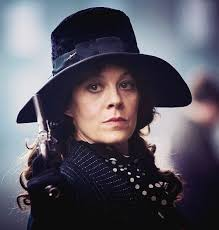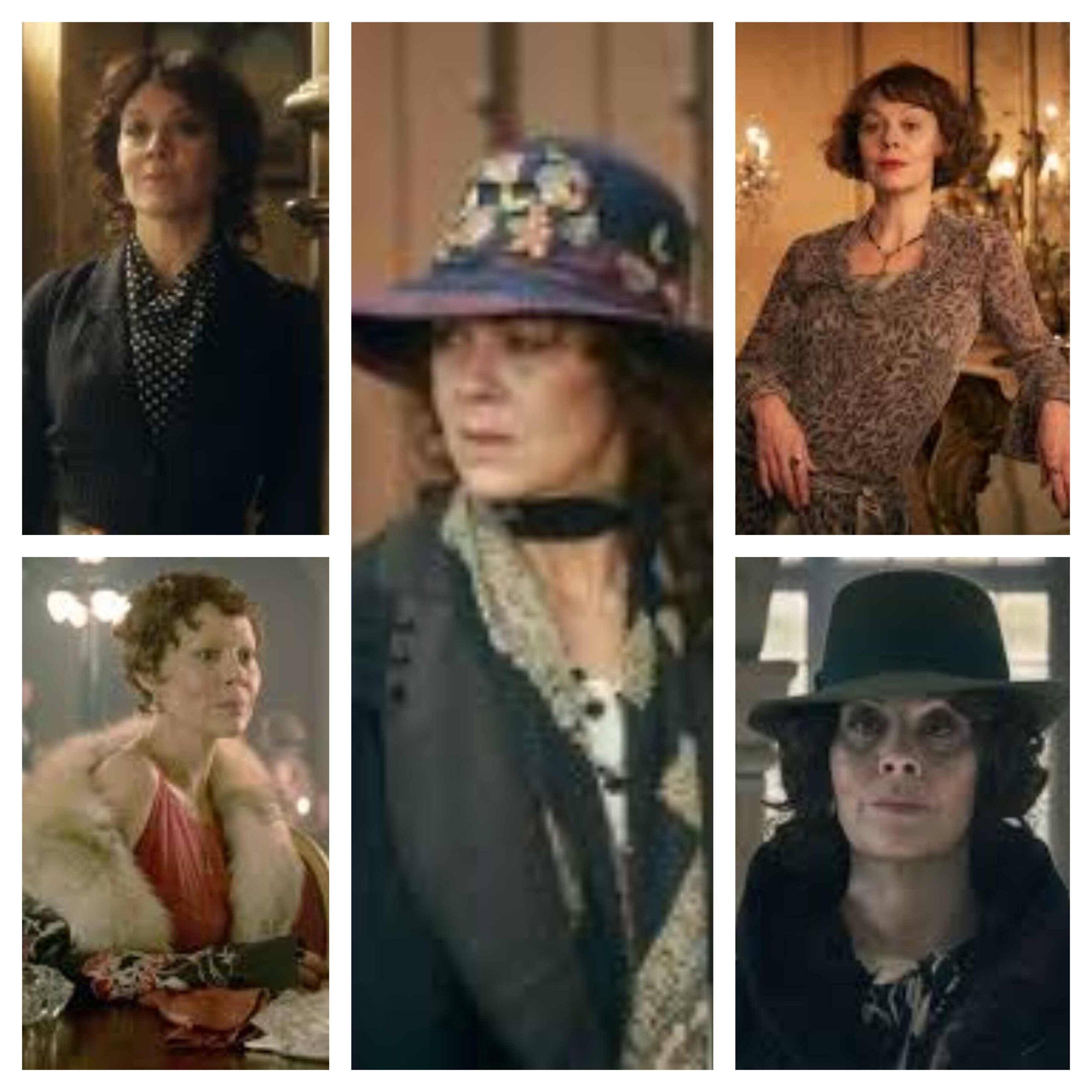
by Purba | Apr 6, 2024 | Style Analysis of Famous Characters |
Introduction:
In the gritty world of Peaky Blinders, where every character is defined by their distinct style, Aunt Polly stands out as a true fashion icon. Also known as Polly Gray/Anna Gay/Polly Anna, as the matriarch of the Shelby family, she commands attention not only with her sharp wit but also with her impeccable taste in clothing. Join us as we unravel Aunt Polly’s style, dissecting the elements that make her style so iconic and timeless.
Aunt Polly, the Epitome of Peaky Blinders’ Style:
In the streets of post-World War I Birmingham, fashion isn’t just a frivolous pursuit; it’s a statement of power and identity. And no one understands this better than Aunt Polly. With her tailored suits, bold accessories, and fearless attitude, she embodies the essence of Peaky Blinders’ style, effortlessly blending sophistication with street smarts.
One of Aunt Polly’s signature pieces is her vintage Chanel jacket, a timeless investment that epitomizes her refined taste. Paired with a simple white blouse and tailored trousers, it effortlessly elevates any outfit, adding a touch of Parisian chic to her ensemble. Proud aunt of Tommy Shelby, Aunt Polly has a vintage taste no doubt.
But it’s not just about high-end designer labels for Aunt Polly; she’s equally adept at mixing vintage finds with contemporary pieces. A thrifted silk scarf adds a pop of color to her ensemble, while a pair of well-worn leather boots lend a touch of rugged charm.

Figure 1: Aunt Polly in one of her tailored suits, exuding power and confidence.

Figure 2: Aunt Polly in one of her tailored suits, exuding power and confidence
Aunt Polly’s Style Evolution:
Throughout the seasons of Peaky Blinders, Aunt Polly’s style undergoes subtle yet significant changes, reflecting both her personal journey and the shifting dynamics of the world around her. In the early seasons, her wardrobe is characterized by understated elegance and practicality, mirroring her role as the steadfast matriarch of the Shelby family.

Figure 3: Aunt Polly’s Style Evolution
As the series progresses, however, we see Aunt Polly embracing a more daring and avant-garde approach to fashion. She experiments with bold patterns, luxurious fabrics, and statement accessories, signaling her desire to break free from the constraints of her past and carve out a new identity for herself.
One of the most striking examples of Aunt Polly’s style evolution is her iconic feathered hat, which becomes a recurring motif throughout the later seasons of Peaky Blinders. Symbolizing her newfound sense of liberation and self-expression, the hat serves as a visual representation of Aunt Polly’s journey from a woman bound by tradition to one who dares to defy expectations.
Aunt Polly’s Fashion Legacy:
Beyond the confines of the small screen, Aunt Polly’s influence on fashion extends far and wide. Her signature style has inspired countless fans and designers alike, sparking a resurgence of interest in vintage silhouettes, tailored suits, and bold accessories.
In the world of haute couture, designers draw inspiration from Aunt Polly’s eclectic mix of masculine and feminine elements, reinterpreting her classic looks for the modern woman. Runway shows are filled with nods to Peaky Blinders’ style, from pinstripe suits to oversized hats adorned with feathers.
Off the runway, fashion enthusiasts embrace Aunt Polly’s fearless approach to dressing, incorporating elements of her iconic style into their own wardrobes. Vintage boutiques see a surge in demand for tailored suits and statement accessories, as women seek to capture the essence of Aunt Polly’s timeless elegance.
Embracing Aunt Polly’s Style:
So, how can you incorporate Aunt Polly’s iconic style into your own wardrobe? It’s all about striking the perfect balance between elegance and edge, mixing tailored pieces with bold accessories and unexpected details.
Start by investing in a well-tailored suit in a rich, sophisticated color like burgundy or navy. Look for classic menswear-inspired cuts with feminine touches, such as a slim-fit blazer paired with high-waisted trousers. This timeless ensemble will serve as the foundation of your Aunt Polly-inspired look.
Next, add a touch of drama with statement accessories. Look for bold brooches, oversized hats, and vintage-inspired scarves to elevate your outfit and capture Aunt Polly’s fearless attitude. Don’t be afraid to experiment with different textures and patterns, mixing and matching pieces to create a look that’s uniquely your own.
Finally, embrace the power of confidence. Aunt Polly’s style isn’t just about what she wears; it’s about how she wears it. Stand tall, walk with purpose, and exude the same sense of self-assuredness that defines Aunt Polly’s character. After all, true style is about owning who you are and expressing yourself with authenticity and flair.
You can also read:
Unveiling the Timeless Elegance of Cillian Murphy’s Style
Hermione’s Style: Timeless Elegance and Intelligence
Harry Potter’s Style: From the Boy Who Lived to a Fashion Icon
Embracing the Iconic Style of Robert Downey Jr.: A Dive into the Fashion Sense of a Hollywood Legend
Achilles Dress Style: A Timeless Symbol of Strength and Elegance
Brad Pitt’s Style: Unlocking the Timeless Elegance
You can write to us at fashionnovationfd@gmail.com
We read and publish your well-written articles!
![Transformation in Fashion Industry]()
by Purba | May 8, 2021 | Top fashion news |
In this era, to be “out of fashion” is indeed to be out of the world. Why so? Well, we already know the reason. Fashion, which is as old as time and as new as tomorrow, is one of the most powerful forces in our life. It influences every sector of our lifestyle. So, to understand the living, breathing and evolving transformation in fashion industry is a need of the hour!
Although the Fashion Industry is considered to be the most glamorous and dynamic fields in the world, it is also difficult, demanding and unpredictable.
Despite the enchanting interplay of creativity, business hype and marketing wit, everything comes down to the bottom line if the fashion companies can’t get profit up to the mark.
In recent years, the fashion industries have undergone dramatic restructuring. The industry does not resemble the one that existed 20 years ago.
Just as fashion products change, the industry itself keep revolving. However, we have seen fashion retailers competing with each other to provide newly fashion trends revealed by fashion shows and runways.
Here are some factors which are driving the transformation in fashion industry:
Elevation of mass production
Prior to the mid 1980s , success in the fashion industry was dependent on low cost mass production of standard designs that did not change often due to the design restrictions of the factories. Evidently, consumers during that time were less conscious of style and fashion and mostly preferred basic apparel or wearings.
Fashion garments began to be mass produced towards the mid-20th century. People began to have more choices of garments as the bulk of production increased.
At the end of the 20th century, fashion awareness among people raised on the top, and they began to choose comfy as well as stylish clothes for themselves, instead of counting on the trends prevailing in the market.
Fast Fashion
Fast fashion is a very known term that has allowed anyone to dress following the latest trends whether he or she has the least of fashion sense.
Spending a little amount but dressing in a different way has become the norm for most people in the last two decades, and that is the reason driving the success of the “fast fashion” trend.
Customers love to see various products or designs every month and this has led to an increase in the demand for new fashion collections over a smaller span of time. And so, to be profitable in the industry, apparel retailers need to take the ‘speed to market’ approach to make profit on fashion that is not in the stores of their competitors.
By emerging small collections of merchandise, fashion retailers encourage consumers to visit their stores more frequently with the idea of ‘Here Today, Gone Tomorrow’. And it surely indicates a shorter life cycle of a particular design or a garment.

Difference in the styling of apparels. Courtesy: Pinterest.
Technological Impact
There was a time previously when the creation of garments required much time and skill, whereas today they are realised within a matter of minutes.
However, today is a combination of all techniques to have been practiced until now. Such as, some designers love to work with the very ancient spindle techniques for their woven styles, but might use a 3D printer for their footwear or ornaments.
The development of technology gives designers a wide choice of techniques to use and it arises constant opportunities. Moreover-
- Nowadays traditional design methods are being replaced by CAD (Computer-Aided Design), CAM (Computer-Aided Manufacturing) or many other designing platforms which minimizes the time of sketching on paper, draping fabrics on mannequins or having a proper measurement. And so these technologies allow the designers to make any kind of changes required for the desired silhouette or fabric trimmings.
- For having a true-to life garment visualization or virtual sampling, we can now easily use some 3D designing software like CLO, Marvelous Designer, MAYA, TUKA 3D etc. Most of our fashion industries get benefited from these 3D garment simulations; as these have gradually reduced the machinery cost or labour cost.
- High-intensity lasers or computer-guided knives are a great replacement of traditional pattern making system as one can get many layers of fabric all at once. But these technologies are mainly used in making expensive apparels.

Pattern making. Courtesy: Pexels.
The assembling of ancient and modern techniques depicts that designers can choose the most sustainable options, and drive the evolution of fashion towards sustainability.
Online shopping & E-commerce for smoothing the digital transformation in fashion industry
Today’s digital world is more and more interconnected with our fashion industry. Digital platforms are becoming prevalent in the fashion market. Every now and then we can see many new brands are emerging with the development of e-commerce, which allows companies to engage consumers through virtual reality.
- The global pandemic (COVID-19) has transformed the way consumers behave and made it amply clears how technology can be lifted to accumulate sales even when consumers are locked in their homes.
- Another withholding factor to the rise of e-commerce is the availability of smartphones and devices. Moreover, there is a huge upsurge in 4G and 5G adoption, which indicates a developed infrastructure of a country.
- While renowned fashion businesses have already joined the e-commerce bandwagon, small shops or boutiques are now also seen entering the homes of prospective buyers via fashion apps, social media pages and garnering followers. As a result, customisation has evolved; creating one’s own shopping basket, having discounts and loyalty points on shopping sites have now become a rewarding experience.
- During this social media era, the fashion industry is experiencing the increasing role of influencers, as consumers look at their lifestyle as more authentic and attractive than habitual advertisements. Influencers are considered as close to the common people because they are not models and are not forced to make a campaign, but wear what they like and what flaunts their body well; they also show their outfits during regular days or in common. Thus it gets easier for ordinary people or customers to adopt the trend followed by the influencers.
The adoption and popularity of e-commerce have manifested that being digital is the only way forward. As consumers build on their impulses, fashion platforms need to up their game to personalize their offerings to the varied tastes and build predictability within their boundaries, to better purchase experiences.

Customization of a particular attire brings the transformation in fashion industry
Personalization:
Consumers have become more squeamish and more demanding during the last few years. It builds a high expectation for quality products among the consumers. They choose fashion items according to their values and their personal style. To cope up with the expectations, fashion companies have to understand how to offer product that customers will perceive as unique. Many fashion companies have followed this trend by enlightening their product portfolio and becoming more and more “multi-style brands”.
Sometimes the company has to think about what is the difference that makes the product of a brand incomparable for both customers and competitors. A wrong choice can instantly destroy the brand reputation, thus they have to be very careful with the selection.
The fashion industry is one of innovation, vision and diversity. And of course, we do not need a reminder of this, but in the fast pace of life, it can be easy to get caught in the rapid movement of our works with all the deadlines and trends. We need to juggle with our innovative ideas, customer feedback and our internal communications as well as to create beautiful and sustainable garments as quickly as possible, following the brand’s image and values.
By Team Saturnine,
Mentor: Tanvir Ahamed Fahad; Id:2018-1-6-026
Leader: Atkia Faiza; Id: 2019-1-6-020
Executive: Md. Asaduzzaman Ovi; Id:2020-1-6-020
Dept: Textile Fashion & Design
Photo References:
- Image 1: Unsplash
- Image 2: Pinterest
- Image 3: Pexels
- Image 4: Pexels
You can also read another of our premium content on Fashion in the 21st century!
If you are interested in architecture and fashion, you can also read Architecture Fabric: The New Use of Textiles as A Building Material
Cybersecurity in Fashion: How SpamTitan Helps Protect Fashion Brands from Cyber Threats




